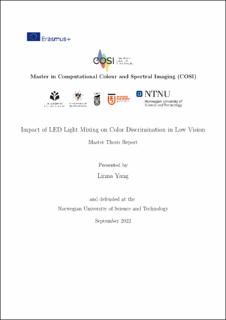| dc.description.abstract | With the accelerated aging of the population, the number of people with low vision continues to rise. According to WHO, the majority of this group is beyond the age of 50, and 81 percent have never experienced a visual issue before. Visual impairment can have a significant impact on the quality of life and the ability of patients to live safely and independently. This study proposes an LED-based lighting strategy to aid those with age-related vision impairment. The methodology relies on psychophysical investigations using the arrangement of standard color samples. Under varying illumination conditions generated by a 24-channel multi-spectral lighting system, volunteers utilizing low vision simulation goggles performed this task. A filtering technique employing different color rendering indices and color measurements allowed for the objective determination of illumination conditions with the best color discrimination scores. The results of the experiment were utilized to combine three channels to produce white light that induces a stronger color perception in a low vision environment than the white LEDs currently used for general illumination. Even if further research is required, these preliminary findings offer hope for the development of intelligent lighting solutions that adapt to the visual needs of the visually impaired. | |
